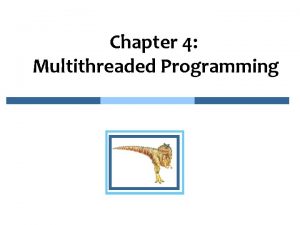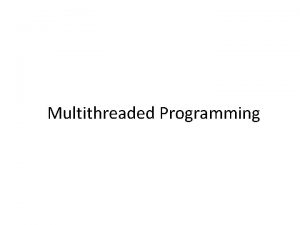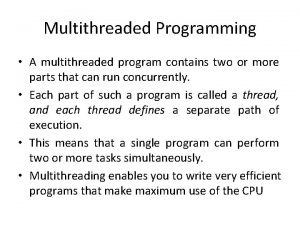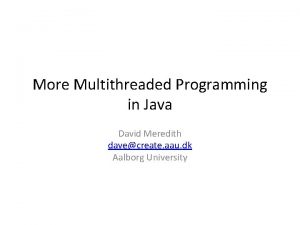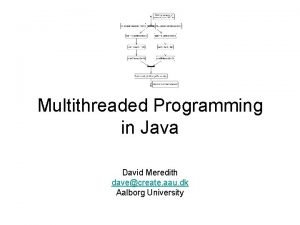More Multithreaded Programming in Java Multimedia Technology Programming












- Slides: 12

More Multithreaded Programming in Java Multimedia Technology Programming http: //mea. create. aau. dk/course/view. php? id=26 Medialogy, Semester 7 Aalborg University, Aalborg 2010 David Meredith dave@create. aau. dk

Sources • Chapter 14 of The Java Programming Language (Fourth Edition) by Ken Arnold, James Gosling and David Holmes (Addison. Wesley, 2006) • Sun Java Tutorial on Concurrency http: //java. sun. com/docs/books/tutorial/essential/c oncurrency/

Synchronized methods and statements • The two code fragments to the right are equivalent • In both cases, the object referenced by this is locked while do. This() and do. That() are carried out • Remember that this refers to the object on which the method is called public synchronized void my. Method() { do. This(); do. That(); } public void my. Method() { synchronized(this) { do. This(); do. That(); } }

Client-side and server-side synchronization • Server-side synchronization is where object to be locked takes responsibility for synchronizing code that uses it – often by using a synchronized method • Client-side synchronization is where responsibility for synchronizing critical regions of code lies with the code that uses the object to be locked – Means every client has to agree to use synchronized code – Less safe than server-side synchronization – Often done using synchronized statements

Synchronized statements vs. synchronized methods • Synchronized statement can protect code region smaller than a whole method • Synchronized statement can lock an object other than the one whose method contains the code being protected • Allows for holding a lock for as short a time as possible (increases performance) • Allows for increasing concurrency by using a finer granularity of locking

Interrupts • If b is a Thread, then we interrupt b (“send an interrupt request to b”) by using the message b. interrupt(); • If Thread b frequently calls methods that throw Interrupted. Exception (e. g. , Thread. sleep()), then the first occurrence of such a method after the interrupt is received will throw an Interrupted. Exception – In this case, we define how the Thread responds to the interrupt in a catch clause (see Ping. Pong. Runnable. java) – Usually the run() method will be made to return

Manually responding to an interrupt public void run() { for (int i = 0; i < 300; i++) { do. Some. Calc(i); if (Thread. interrupted()) { return; } } } public void run() { try { for (int i = 0; i < 300; i++) { do. Some. Calc(i); if (Thread. interrupted()) { throw new Interrupted. Exception(); } } } catch (Interrupted. Exception e) { do. Some. Stuff(); return; } } • Sometimes a run() method might not contain any call to a method that throws an Interrupted. Exception • In this case, need to regularly check whether the Thread has received an interrupt • Using a try-catch clause allows you to centralize the interrupt handling code in one place and separate it clearly from the run code

Interrupt status flag • Message, thr. A. interrupt() causes interrupt status flag to be set to true for Thread thr. A • If thr. A checks for interrupt status by calling static method, Thread. interrupted(), then interrupt status flag set to false (“cleared”) – thr. A ceases to be in an interrupted state • If Thread thr. B wants to know if Thread thr. A has been interrupted, then call thr. A. is. Interrupted() from inside thr. B – Does not clear interrupt status flag – That is, if thr. A has been interrupted, it remains in an interrupted state, as indicated by the true value of the interrupt status flag • When Interrupted. Exception thrown, interrupt status flag is cleared (i. e. , set to false) – thread ceases to be in an interrupted state

The join method • The call, t. join() causes the current Thread to block (i. e. , stop doing anything) until Thread t has stopped running • The join method throws an Interrupted. Exception if the current Thread is interrupted while it is waiting for another Thread to complete • See Hr. Og. Fru. Jensen 2. java

Simple. Threads. java

Guarded Blocks public void guarded. Joy() { while (!joy) {} System. out. println(“Joy has been achieved!”); } • A guarded block suspends the current thread until another thread makes some condition become true, which restarts the current thread • guarded. Joy() method must not execute its last line until the shared variable joy has been made true by some other thread • The while loop is keeping the processor busy while it is waiting (busy waiting) – DON’T DO THIS!

Guarded blocks using wait and notify. All Achieving. Joy. java
 More more more i want more more more more we praise you
More more more i want more more more more we praise you More more more i want more more more more we praise you
More more more i want more more more more we praise you Real time example of multithreading in java
Real time example of multithreading in java Jumlah level dalam gambar ini adalah . . . .
Jumlah level dalam gambar ini adalah . . . . Multithreaded games
Multithreaded games Multithreaded algorithms
Multithreaded algorithms Apt multithreaded
Apt multithreaded Multimedia becomes interactive multimedia when
Multimedia becomes interactive multimedia when Hyperactive multimedia examples
Hyperactive multimedia examples Csc253 interactive multimedia
Csc253 interactive multimedia Esa multimedia.esa.int./multimedia/virtual-tour-iss
Esa multimedia.esa.int./multimedia/virtual-tour-iss Define multimedia technology
Define multimedia technology Iat 265
Iat 265













